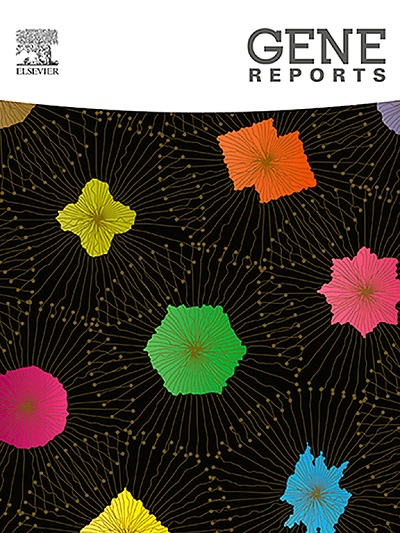Genomic characterization and comparative genomics of Chlorella sp. CH2018 from Musi River water, India
IF 1
Q4 GENETICS & HEREDITY
引用次数: 0
Abstract
Microalgae, a diverse class of photosynthetic eukaryote, can provide food and energy sustainably. Selecting productive strains is crucial for commercial viability. Here, we isolated an axenic microalgal species from Musi River water, and based on its morphology, molecular makeup, and cell wall composition identified it as Chlorella sp. CH2018. Scanning electron microscopy was used to measure the size of cells, which were found to be 3-, 4-, or 5-μm in diameter with a discernible thick outer cell wall. The characterization of algal genomes is imperative for comprehending species, studying metabolic pathways, and modifying genetics. In this study, we sequenced the entire genome of Chlorella sp. CH2018, yielded genome size of 56.83 Mb with 11,143 functionally annotated protein-coding gene models. The Gene Ontology (GO) analysis revealed that Chlorella's predominant metabolic pathway is carbohydrate metabolism. Ortholog comparative analysis of species of phylum Chlorophyta with Chlorella sp. CH2018 showed that the isolated species possesses unique protein families with a maximum number of 6292 ortholog groups with Chlorella sorokiniana. The phylogenetic tree created by concatenating single-copy ortholog sequences demonstrates the uniqueness of Chlorella sp. CH2018, and its genome sequence serves as a genetic resource for future research.
印度穆西河水中小球藻 CH2018 的基因组特征和比较基因组学
微藻类是一类种类繁多的光合真核生物,可持续提供食物和能源。选择高产菌株对商业可行性至关重要。在此,我们从穆西河水中分离出一种轴生微藻,并根据其形态、分子组成和细胞壁成分确定其为小球藻 CH2018。利用扫描电子显微镜测量了细胞的大小,发现其直径为 3、4 或 5 微米,细胞外壁很厚。藻类基因组的特征对于了解物种、研究代谢途径和修改遗传学至关重要。在这项研究中,我们对小球藻 CH2018 的全基因组进行了测序,获得了 56.83 Mb 的基因组大小和 11,143 个功能注释的蛋白编码基因模型。基因本体(GO)分析表明,小球藻的主要代谢途径是碳水化合物代谢。叶绿藻门物种与 Chlorella sp. CH2018 的同源物比较分析表明,该分离物种拥有独特的蛋白质家族,与 Chlorella sorokiniana 的同源物组数最多,达 6292 个。通过串联单拷贝直向同源物序列建立的系统发生树证明了 CH2018 小球藻的独特性,其基因组序列可作为未来研究的遗传资源。
本文章由计算机程序翻译,如有差异,请以英文原文为准。
求助全文
约1分钟内获得全文
求助全文
来源期刊

Gene Reports
Biochemistry, Genetics and Molecular Biology-Genetics
CiteScore
3.30
自引率
7.70%
发文量
246
审稿时长
49 days
期刊介绍:
Gene Reports publishes papers that focus on the regulation, expression, function and evolution of genes in all biological contexts, including all prokaryotic and eukaryotic organisms, as well as viruses. Gene Reports strives to be a very diverse journal and topics in all fields will be considered for publication. Although not limited to the following, some general topics include: DNA Organization, Replication & Evolution -Focus on genomic DNA (chromosomal organization, comparative genomics, DNA replication, DNA repair, mobile DNA, mitochondrial DNA, chloroplast DNA). Expression & Function - Focus on functional RNAs (microRNAs, tRNAs, rRNAs, mRNA splicing, alternative polyadenylation) Regulation - Focus on processes that mediate gene-read out (epigenetics, chromatin, histone code, transcription, translation, protein degradation). Cell Signaling - Focus on mechanisms that control information flow into the nucleus to control gene expression (kinase and phosphatase pathways controlled by extra-cellular ligands, Wnt, Notch, TGFbeta/BMPs, FGFs, IGFs etc.) Profiling of gene expression and genetic variation - Focus on high throughput approaches (e.g., DeepSeq, ChIP-Seq, Affymetrix microarrays, proteomics) that define gene regulatory circuitry, molecular pathways and protein/protein networks. Genetics - Focus on development in model organisms (e.g., mouse, frog, fruit fly, worm), human genetic variation, population genetics, as well as agricultural and veterinary genetics. Molecular Pathology & Regenerative Medicine - Focus on the deregulation of molecular processes in human diseases and mechanisms supporting regeneration of tissues through pluripotent or multipotent stem cells.
 求助内容:
求助内容: 应助结果提醒方式:
应助结果提醒方式:


